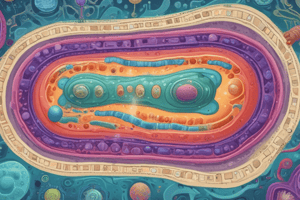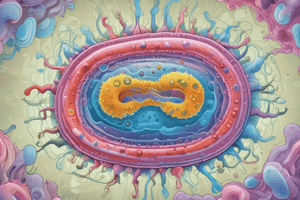Podcast
Questions and Answers
What distinguishes eukaryotic cells from prokaryotic cells?
What distinguishes eukaryotic cells from prokaryotic cells?
- Eukaryotic cells have a single, circular chromosome.
- Eukaryotic cells do not have a nucleus.
- Eukaryotic cells have no genetic material.
- Eukaryotic cells possess membrane-bound organelles. (correct)
Which of the following structures is typically found in plant cells but absent in animal cells?
Which of the following structures is typically found in plant cells but absent in animal cells?
- Cytoskeleton
- Glycogen granules
- Cell walls (correct)
- Centrioles
Inclusion bodies in prokaryotic cells primarily serve what function?
Inclusion bodies in prokaryotic cells primarily serve what function?
- Locomotion
- Storage of reserve materials (correct)
- Energy production
- Genetic material organization
Which type of bacteria contains gas vacuoles?
Which type of bacteria contains gas vacuoles?
What feature is characteristic of animal cells but not typically found in plant cells?
What feature is characteristic of animal cells but not typically found in plant cells?
What is a characteristic feature of prokaryotes?
What is a characteristic feature of prokaryotes?
Which layer of the prokaryotic cell envelope provides structural support?
Which layer of the prokaryotic cell envelope provides structural support?
How are prokaryotic bacteria classified based on their cell envelope?
How are prokaryotic bacteria classified based on their cell envelope?
What distinguishes the glycocalyx in different bacterial types?
What distinguishes the glycocalyx in different bacterial types?
What is the function of the plasma membrane in prokaryotic cells?
What is the function of the plasma membrane in prokaryotic cells?
Which statement is true regarding the structure of prokaryotic cell envelopes?
Which statement is true regarding the structure of prokaryotic cell envelopes?
What type of glycocalyx is characterized as a loose sheath?
What type of glycocalyx is characterized as a loose sheath?
What similarity exists between the plasma membrane of prokaryotes and eukaryotes?
What similarity exists between the plasma membrane of prokaryotes and eukaryotes?
What is the primary function of chloroplasts in plants?
What is the primary function of chloroplasts in plants?
Which type of plastid is responsible for storing carbohydrates?
Which type of plastid is responsible for storing carbohydrates?
Which pigment is contained in chloroplasts that aids in photosynthesis?
Which pigment is contained in chloroplasts that aids in photosynthesis?
What distinguishes chromoplasts from chloroplasts?
What distinguishes chromoplasts from chloroplasts?
What shape are chloroplasts typically?
What shape are chloroplasts typically?
In which part of the plant are chloroplasts most commonly found?
In which part of the plant are chloroplasts most commonly found?
What is the main role of leucoplasts?
What is the main role of leucoplasts?
How many chloroplasts can typically be found in the mesophyll cells of a plant?
How many chloroplasts can typically be found in the mesophyll cells of a plant?
What primarily allows the lateral movement of proteins within the lipid bilayer?
What primarily allows the lateral movement of proteins within the lipid bilayer?
Which process describes the movement of water across a membrane?
Which process describes the movement of water across a membrane?
Which type of transport requires energy to move molecules against their concentration gradient?
Which type of transport requires energy to move molecules against their concentration gradient?
Which structure protects plant and fungal cells from mechanical damage?
Which structure protects plant and fungal cells from mechanical damage?
How do polar molecules typically cross the lipid bilayer?
How do polar molecules typically cross the lipid bilayer?
What is essential for the formation of intercellular junctions according to the fluid nature of the membrane?
What is essential for the formation of intercellular junctions according to the fluid nature of the membrane?
What common feature do both passive and active transport share?
What common feature do both passive and active transport share?
The Na+/K+ pump is an example of which type of transport?
The Na+/K+ pump is an example of which type of transport?
What is the primary function of mitochondria within the cell?
What is the primary function of mitochondria within the cell?
What structure inside the mitochondrion increases its surface area?
What structure inside the mitochondrion increases its surface area?
What components are found in the mitochondrial matrix?
What components are found in the mitochondrial matrix?
What type of cellular division do mitochondria undergo?
What type of cellular division do mitochondria undergo?
Which of the following statements about mitochondria is incorrect?
Which of the following statements about mitochondria is incorrect?
What is the diameter range of a typical mitochondrion?
What is the diameter range of a typical mitochondrion?
Where are mitochondria located within the cell?
Where are mitochondria located within the cell?
In which type of cells are plastids typically found?
In which type of cells are plastids typically found?
Flashcards are hidden until you start studying
Study Notes
Prokaryotic Cells
- Prokaryotes possess inclusions as unique features for storage.
- Mesosomes, specialized infoldings of the cell membrane, are characteristic of prokaryotes.
- Prokaryotic cell envelopes are complex and consist of three layers: glycocalyx, cell wall, and plasma membrane.
- The glycocalyx can vary in composition; a loose slime layer or a thick capsule provides protection.
- The cell wall maintains cell shape and structural integrity, preventing lysis or collapse.
- The plasma membrane is selectively permeable and interacts with the external environment.
- Inclusion bodies within prokaryotic cells store reserve materials and lack a membrane.
- Examples of inclusion bodies include phosphate granules, cyanophycean granules, and glycogen granules.
- Gas vacuoles are present in photosynthetic bacteria, aiding in buoyancy.
Eukaryotic Cells
- Eukaryotes include diverse organisms: protists, plants, animals, and fungi.
- These cells feature extensive compartmentalization via membrane-bound organelles.
- Eukaryotic cells have an organized nucleus enclosed by a nuclear envelope.
- Genetic material is organized into chromosomes, allowing for complex genetic regulation.
- Plant cells possess cell walls, plastids, and large central vacuoles, while animal cells contain centrioles.
- The fluidity of the lipid membrane allows protein mobility within the bilayer, impacting cell functions like growth and transport.
Plasma Membrane Functions
- The plasma membrane is selectively permeable, regulating molecule transport.
- Passive transport involves the movement of molecules along their concentration gradient without energy, such as simple diffusion and osmosis for water.
- Active transport requires energy (ATP) for moving substances against their concentration gradient, exemplified by the Na+/K+ pump.
Cell Wall
- The cell wall is a rigid structure surrounding the plasma membrane in fungi and plants.
- It provides shape, mechanical protection, and acts as a barrier to undesirable substances.
Mitochondria
- Mitochondria are double membrane-bound organelles, varying in number and shape (0.2-1.0µm in diameter, 1.0-4.1µm in length).
- Inner compartments (matrix) contain enzymes, ribosomes (70S), and circular DNA, and are sites of aerobic respiration, producing ATP as energy.
- The inner membrane features infoldings called cristae, increasing the surface area for metabolic reactions.
Plastids
- Plastids are prominent in plant cells and euglenoids, classified into chloroplasts, chromoplasts, and leucoplasts.
- Chloroplasts contain chlorophyll, essential for photosynthesis, while chromoplasts store carotenoid pigments, imparting colors.
- Leucoplasts are colorless plastids that store nutrients such as carbohydrates (amyloplasts), oils (elaioplasts), and proteins (aleuroplasts).
- Chloroplasts vary in number from one in Chlamydomonas to 20-40 in mesophyll cells; they are also double membrane-bound.
Studying That Suits You
Use AI to generate personalized quizzes and flashcards to suit your learning preferences.




